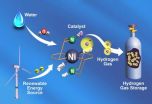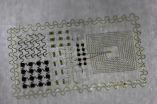(Press-News.org) In both chimpanzees and humans, portions of the brain that are critical for complex cognitive functions, including decision-making, self-awareness and creativity, are immature at birth. But there are important differences, too. Baby chimpanzees don't show the same dramatic increase in the volume of prefrontal white matter in the brain that human infants do.
Those are the conclusions of a study reported in the August 11th Current Biology, a Cell Press publication, that is the first to track the development of the chimpanzee brain over time and to make the comparison to humans.
"One of the most marked evolutionary changes underlying human-specific cognitive traits is a greatly enlarged prefrontal cortex," said Tetsuro Matsuzawa of Kyoto University in Japan. "It is also one of the latest-developing brain regions of the cerebrum."
That built-in developmental delay, now shown to be shared with chimps, may provide an extended period of plasticity, allowing both humans and our closest evolutionary cousins to develop complex social interactions, knowledge and skills that are shaped by life experiences, the researchers say.
"Both humans and chimpanzees need to render their neural network and brain function more susceptible to the influence of postnatal experience," Matsuzawa said.
For instance, he added, both chimps and humans enjoy close relationships between infants and adults, as indicated by smiles and mutual gazes. On the other hand, the greater prefrontal expansion in the human brain may contribute to the development of language, complex social interaction and other abilities that are unique to us.
Matsuzawa's team made their discoveries by studying magnetic resonance imaging (MRI) scans of three growing chimpanzees from the age of six months to six years, when chimps reach pre-puberty.
The findings suggest that a less mature and more protracted elaboration of neuronal connections in the prefrontal portion of the developing brain existed in the last common ancestor of chimpanzees and humans. That commonality is in contrast to what has been observed in studies of our more distant ancestors, the macaques.
Matsuzawa says his group is interested in exploring when over the course of evolutionary time this feature of brain development evolved. His team also hopes to explore the comparison between human and chimpanzee brains into young adulthood, noting that the chimpanzees they studied have entered late puberty at 11-years-old.
### END
Like humans, chimps are born with immature forebrains
2011-08-12
ELSE PRESS RELEASES FROM THIS DATE:
For bugs within bugs within mealybugs, life is a 'patchwork'
2011-08-12
Bacteria may have bad reputations but in fact, all animals -- us included -- rely on them in critical ways. In the case of sap-feeding insects, intimate associations with microbes offer a source for essential nutrients that their sugary diets just don't include. Now, researchers reporting in the August 11th Current Biology, a Cell Press publication, have new insight into organisms that have taken this symbiotic lifestyle to the extreme; they have sequenced the genomes of two species of bacteria that live together, one inside of the other, inside mealybugs.
The effort ...
Catalyst that makes hydrogen gas breaks speed record
2011-08-12
RICHLAND, Wash. -- Looking to nature for their muse, researchers have used a common protein to guide the design of a material that can make energy-storing hydrogen gas. The synthetic material works 10 times faster than the original protein found in water-dwelling microbes, the researchers report in the August 12 issue of the journal Science, clocking in at 100,000 molecules of hydrogen gas every second.
This step is just one part of a series of reactions to split water and make hydrogen gas, but the researchers say the result shows they can learn from nature how to control ...
Stick-on tattoos go electric
2011-08-12
VIDEO:
The video describes the new epidermal electronics system and shows how it is applied to the skin.
Click here for more information.
Through a combination of careful theoretical modeling and precise micro-manufacturing, a team of engineers and scientists has developed a new type of ultra-thin, self-adhesive electronics device that can effectively measure data about the human heart, brain waves and muscle activity – all without the use of bulky equipment, conductive ...
URALCHEM HOLDING P.L.C. Reports The First Half Of Year 2011 Unaudited IFRS Financial Results
2011-08-12
- Revenue increased to US $ 1.035 billion, compared to US $ 663 million
in H1 2010
- Operating profit increased to US $ 288 million, compared to US $ 83 million
in H1 2010
- Adjusted EBITDA grew to US $ 337 million, compared to US $ 137 million
in H1 2010
- Net profit amounted to US $ 244 million, compared to net loss of US $ 13 million in H1 2010
URALCHEM Holding P.L.C. (hereinafter URALCHEM Holding or the Company), a Cypriot holding company of the URALCHEM Group (hereinafter called the Group), one of the largest producers of nitrogen and phosphate fertilisers ...
Smart skin: Electronics that stick and stretch like a temporary tattoo
2011-08-12
VIDEO:
A new form of electronics, small enough to fit under a temporary tattoo, changes the way scientists think about gathering data from the human body.
Click here for more information.
CHAMPAIGN, Ill. — Engineers have developed a device platform that combines electronic components for sensing, medical diagnostics, communications and human-machine interfaces, all on an ultrathin skin-like patch that mounts directly onto the skin with the ease, flexibility and comfort of ...
Natural History Museum of Los Angeles County makes scientific history with 'pregnant plesiosaur'
2011-08-12
August 7, 2011 – A paper to be published on August 12, 2011 in the authoritative magazine Science reveals that Dr. F. Robin O'Keefe of Marshall University in Huntington, W.Va. and Dr. Luis Chiappe, Director of the Natural History Museum's Dinosaur Institute, have determined that a unique specimen now displayed in NHM's Dinosaur Hall is the fossil of an embryonic marine reptile contained within the fossil of its mother.
The 78-million-year-old, 15.4-foot-long adult specimen is a Polycotylus latippinus, one of the giant, carnivorous, four-flippered reptiles known as plesiosaurs ...
NIH-led team maps route for eliciting HIV-neutralizing antibodies
2011-08-12
Researchers have traced in detail how certain powerful HIV neutralizing antibodies evolve, a finding that generates vital clues to guide the design of a preventive HIV vaccine, according to a study appearing in Science Express this week. The discoveries were made by a team led by the Vaccine Research Center (VRC) at the National Institute of Allergy and Infectious Diseases (NIAID), part of the National Institutes of Health.
"This elegant research brings us another step closer to an HIV vaccine and establishes a potent new technique for evaluating the human immune response ...
Supernovae parents found
2011-08-12
Pasadena, CA— Type Ia supernovae are violent stellar explosions whose brightness is used to determine distances in the universe. Observing these objects to billions of light years away has led to the discovery that the universe is expanding at an accelerating rate, the foundation for the notion of dark energy. Although all Type Ia supernovae appear to be very similar, astronomers do not know for certain how the explosions take place and whether they all share the same origin. Now, a team of researchers has examined new and detailed observations of 41 of these objects and ...
Depression linked to increased risk of stroke in women
2011-08-12
Depressed women may face an increased risk of stroke, according to new research reported in Stroke: Journal of the American Heart Association.
In six years of follow-up of women in the Nurses' Health Study, researchers found that a history of depression was associated with a 29 percent increased risk of total stroke – even after considering other stroke risk factors. Women who used anti-depressant medication — particularly selective serotonin reuptake inhibitors— had a 39 percent increased risk of stroke. Examples of these drugs are Prozac, Zoloft, and Celexa.
Anti-depressant ...
Hidden soil fungus, now revealed, is in a class all its own
2011-08-12
ANN ARBOR, Mich.---A type of fungus that's been lurking underground for millions of years, previously known to science only through its DNA, has been cultured, photographed, named and assigned a place on the tree of life.
Researchers say it represents an entirely new class of fungi: the Archaeorhizomycetes. Like the discovery of a weird type of aquatic fungus that made headlines a few months ago, this finding offers a glimpse at the rich diversity of microorganisms that share our world but remain hidden from view.
The fungal phenomenon, brought to light by researchers ...

